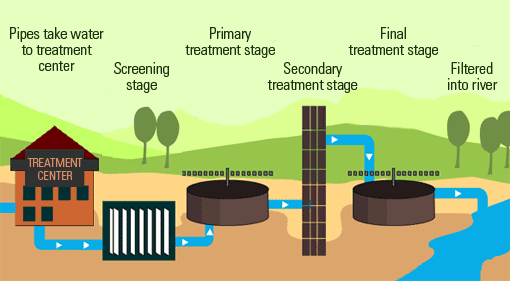Economical Solutions for Large-Scale Waste Water Treatment Facilities
Economical Solutions for Large-Scale Waste Water Treatment Facilities
Blog Article
Strategic Approaches to Enhance Drainage Treatment Effectiveness and Lessen Ecological Impact
In the world of waste water treatment, the quest for improved efficiency and decreased environmental impact is a continuous obstacle that demands strategic solutions. The integration of sophisticated treatment innovations, energy-efficient procedures, resource recuperation approaches, improved nutrient elimination techniques, and smart tracking and control systems stands for a multifaceted framework for addressing these pressing worries.
Advanced Therapy Technologies
Sophisticated membrane layer filtering systems have changed sophisticated wastewater treatment processes, dramatically improving the removal of pollutants. This technology has actually shown to be extremely reliable in getting rid of a wide array of pollutants, including drugs, heavy steels, and organic substances, which are frequently challenging to eliminate via traditional therapy techniques.
In addition, membrane layer filtration systems use various benefits over conventional therapy strategies. They call for much less area, generate higher-quality effluent, and are much more resistant to fluctuations in influent water quality. Furthermore, these systems are very versatile and can be easily integrated into existing therapy plants or made use of as standalone devices for decentralized applications. As the need for clean water remains to increase, the adoption of advanced membrane layer filtration technologies is necessary to make certain reliable and sustainable wastewater treatment practices.
Energy-Efficient Procedures
The combination of energy-efficient processes in wastewater therapy systems is important for optimizing source usage and minimizing functional expenses. One essential approach to boosting energy performance in wastewater treatment is the application of advanced aeration systems, such as great bubble diffusers or surface aerators, which can boost oxygen transfer performance and lower energy intake.
Moreover, enhancing procedure control and automation through making use of advanced sensors and monitoring systems can enhance overall power performance by adjusting operations in real-time based on real demand and problems. Carrying out power audits and on a regular basis keeping an eye on power efficiency indicators are essential methods to determine areas for enhancement and track energy-saving initiatives successfully. On the whole, the fostering of energy-efficient processes in wastewater treatment not just profits the atmosphere however additionally adds to long-term cost financial savings and functional sustainability.
Source Recuperation Methods
With a focus on optimizing source application and sustainability in wastewater therapy systems, the application of source recuperation approaches emerges as a critical element in enhancing functional effectiveness. Resource healing strategies in wastewater therapy involve the identification and removal of valuable sources from the waste stream, consequently transforming what was when considered waste into a valuable property. By carrying out resource recuperation techniques such as nutrient elimination and recuperation, energy generation from natural matter, and the manufacturing of reusable water, wastewater treatment plants can decrease ecological influence while taking full advantage of effectiveness.

Enhanced Nutrient Removal Methods
Executing advanced nutrient removal strategies is crucial for maximizing the efficiency of wastewater therapy systems. One of the key methods utilized for enhanced nutrient elimination is the process of biological nutrient removal (BNR), which includes the elimination of nitrogen and phosphorus via biological procedures.

Along with BNR, advanced treatment techniques such as membrane layer bioreactors (MBRs) and constructed marshes can also be utilized to boost nutrient removal effectiveness. MBRs utilize membrane check layers to achieve high-grade effluent requirements by successfully eliminating nutrients and suspended solids. Constructed wetlands mimic natural marsh procedures to eliminate nutrients through plant uptake, microbial task, and sedimentation. By incorporating these innovative nutrient elimination techniques into wastewater therapy sectors, systems and towns can successfully decrease nutrient contamination and safeguard the atmosphere.
Smart Surveillance and Control Solution
Using cutting-edge modern technology, the assimilation of wise tracking and control systems revolutionizes the operational performance of wastewater treatment centers. These systems integrate innovative sensors and data analytics to continually monitor essential specifications such as pH levels, turbidity, dissolved oxygen, and circulation prices in real-time. By accumulating and examining this information, operators can get beneficial understandings into the efficiency of the therapy processes, allowing positive modifications to optimize therapy performance.
Smart surveillance and control systems also sustain remote surveillance capacities, permitting drivers to accessibility real-time data and control features from off-site places. This remote access enhances functional adaptability and responsiveness, allowing swift treatments in instance of system malfunctions or fluctuations in influent high quality. The predictive upkeep capacities of these systems aid avoid equipment failings and reduce downtime, ultimately enhancing the overall reliability of wastewater therapy procedures.
Final Thought
In verdict, calculated techniques such as advanced therapy innovations, energy-efficient processes, source healing methods, enhanced nutrient elimination strategies, and wise tracking and control systems play an essential duty in boosting wastewater treatment performance and lessening ecological influence. By carrying out these methods, wastewater treatment plants can improve their total efficiency, decrease energy usage, recoup beneficial resources, and ensure conformity with environmental guidelines. These techniques are crucial for efficient and sustainable wastewater administration methods.

In conclusion, tactical strategies such as sophisticated treatment modern technologies, energy-efficient procedures, resource recovery approaches, enhanced nutrient removal techniques, and smart imp source tracking and my link control systems play a crucial duty in improving wastewater therapy effectiveness and decreasing ecological effect.
Report this page